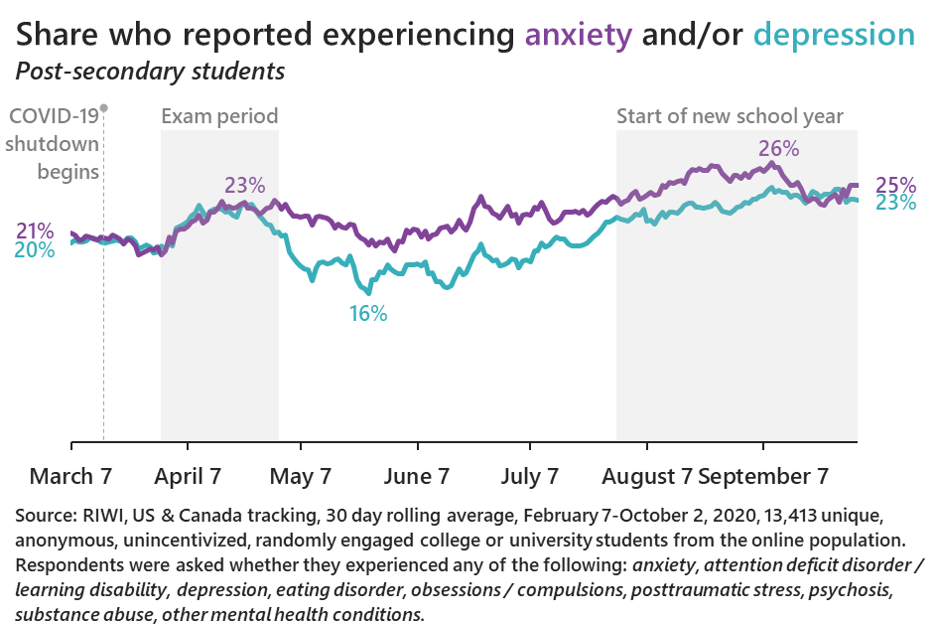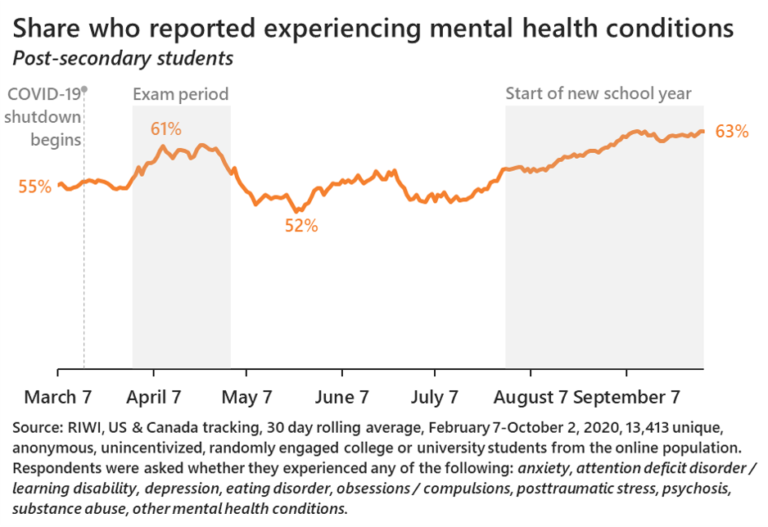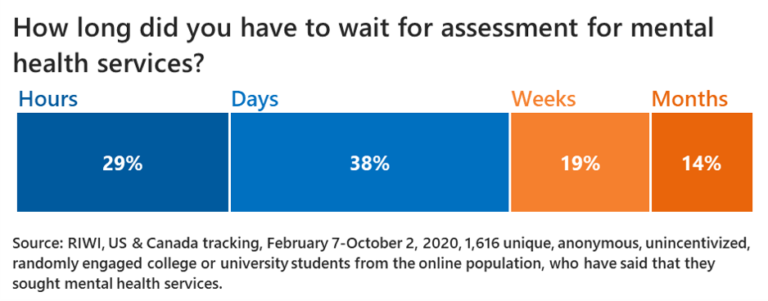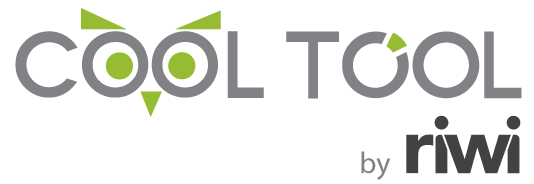By Catherine Barker, Emily Kuzan, and Neil Seeman

Students were in crisis pre-pandemic and the pandemic has compounded the problem
-
Almost three in five post-secondary students in Canada and the US reported that they suffer from one or more mental health conditions, including depression, anxiety, and eating disorders.
-
One in three students seeking mental health services shortly before or during the pandemic reported that they waited weeks or months for a mental health assessment.
-
There was a 10% increase in students reporting mental health conditions during the first wave of the COVID-19 pandemic when compared with the preceding period. This was also a pre-exam period, however, so that precise attribution is impossible.
-
This is the first study (to our knowledge) to collect reliable pre-COVID data on the changing prevalence of a) mental health conditions and b) barriers to access amongst post-secondary students. It also provides continuous comparative data throughout the first seven months of the crisis.
-
To maximize data reliability, we gathered these data anonymously and our technology made it possible to reach over 6,000 post-secondary students. Respondents lived both on and off campus and included those who do not habitually answer conventional surveys.
The goal: Accurate data on mental health conditions / access to care among college and university students in the United States and Canada
For this study, the RIWI team partnered with the Investigative Journalism Bureau at the Dalla Lana School of Public Health at the University of Toronto, and nine other post-secondary institutions across the US and Canada. RIWI’s role was to collect benchmark data on the prevalence, over time, of mental health conditions amongst university and college students in Canada and the US, and their self-reported access to mental health services in 2020.
To our knowledge there are no other robust, reliable continuous data on the prevalence of self-reported mental health conditions among post-secondary students or the accessibility of mental health services. RIWI gathered these data from February 2020 (before the COVID-19 surge in North America) until October 2020 (during the pandemic’s second wave). This allowed for comparison between different periods of the (mostly) online school year and the evolution of the pandemic.
It is not easy to gather reliable data on students’ mental health. For one, young people do not typically answer conventional surveys. Secondly, mental health stigma makes it difficult for students to answer honestly when they think that their responses can be traced back to them. They are especially reluctant to share their experiences when linked to their university or college ID or to their contact information. Therefore, to gather accurate and reliable data on students’ mental health, we used a different approach. We used a technology that randomly exposes the questions to anyone online, and then asked whether they happen to be a post-secondary student. RIWI was able to hear from 6,055 anonymous students across Canada and the US. We do not collect personally identifiable information, which facilitates the sharing of feelings about socially sensitive topics.
This study builds on RIWI’s extensive experience collecting anonymous data on sensitive public health and mental health topics. An early peer-reviewed application of RIWI’s technology was measuring attitudes towards vaccination during the H1N1 flu pandemic in 2009. RIWI also conducted and published a world survey of mental illness stigma in 229 countries to benchmark the prevalence of the stigma attached to mental health conditions around the world in 2016.
The following findings include reference to behavior associated with deteriorating mental health, including self-harm and suicide.
Anxiety and depression were common before and during COVID-19
We asked students if they have experienced any mental health conditions, specifically, anxiety, depression, attention deficit disorder/ learning disability, eating disorder, obsessions/ compulsions, post-traumatic stress disorder, psychosis, substance abuse disorder, other mental health disorders, or none.
The experience of anxiety and depression were the most common mental health conditions reported by students both before and during the pandemic. Over one in five students reported suffering from anxiety; the same proportion reported depression. Indigenous, Black, Latino, and Asian students reported higher prevalence than the rest of the student population for most mental health conditions. Female students reported much higher rates of anxiety and depression than did male students; part-time students reported relatively high rates of all mental health conditions.

The proportion of students who said they had experienced no mental health conditions fell during key times of the pandemic and the school year. Ten percent more students reported suffering from mental health conditions in April compared with February/March, during the first wave of the COVID-19 pandemic and during the move to online schooling for universities and colleges throughout North America. Another rise in those reporting mental health conditions began in July, and rose steadily until our data collection ended in October. Most of this increase came from reports of anxiety and/or depression, the two most common mental health disorders among students in this dataset. 
There was a sharp spike in reports of both anxiety and depression at the end of March and into April when most universities and colleges migrated to online learning and the pre-exam period began. The prevalence of these conditions, especially depression, fell during the post-exam period. However, disclosures of anxiety and depression rose again steadily from July through October, coincident with schools announcing online learning for September. In August, students reported the highest levels of anxiety and depression over the period of data collection as they faced the fall semester of online learning.
We also asked students who reported suffering from mental health conditions whether they had considered specific actions as a result of their mental health, and, if so, which ones. Students were permitted to select all behaviors that applied. Just under one in three in this group considered self-isolation; one in four considered quitting school; over one in five in this group had considered self-harm and/or suicide.

Over one in three students who reported suffering from specified mental health conditions sought mental health services at their school. However, one-third of those students reported waiting weeks or months to be assessed. Just over one in two Canadian students and just under one in two American students were of the opinion that the mental health services at their school were responsive to the needs of students.
Method: Anonymous, and reaching out beyond typical survey respondents
RIWI randomly engaged a total of 2,850 Canadian and 3,475 US post-secondary students aged 17+ from February 7th to October 2nd, 2020 on a continuous 24/7 basis. RIWI gathered these data using a robust and unique technology that elicits responses from the broadest possible swath of the American and Canadian population in real-time – Random Domain Intercept Technology (RDIT). RDIT draws randomly from the entire Web-using population in the US and Canada on a continuous, 24/7 basis. Unlike traditional or online survey approaches, the technology’s algorithms ensure that anyone on the Web has an equal chance of being randomly exposed to the questions. Also, unlike government or school surveys, all data are gathered anonymously, reducing social desirability bias and eliminating a potential barrier to participation. Furthermore, respondents are not incentivized to participate in any way. We randomly engage a new, random set of unique respondents each day; we had no repeat respondents throughout the period. Despite a unique set of fresh respondents each day, the numbers of respondents were such that grouped results remained consistent.
To learn more
A recent Toronto Star series highlighted some of the study’s findings in its November 2020 investigative series Generation Distress.
Researchers interested in accessing these data for publication or academic usage may contact Catherine Barker, at catherinebarker@riwi.com
If you wish to learn about the types of analysis on these data now being undertaken by University-based researchers, or to learn more about our data sets, please contact ask@riwi.com.
About RIWI
RIWI stands for “real-time interactive world-wide intelligence”. We provide access to continuous consumer and citizen sentiment in all countries. RIWI breaks through the noise to find the truth about what people really think, want and observe – by reaching the most diverse audiences, including the disengaged and quiet voices who do not typically answer surveys or express their views on social media. RIWI technology rapidly collects data in every country around the world and displays the results in a secure interactive dashboard in real-time. We only collect anonymous information: 229 countries and territories, over 80 languages and 1.6 billion interviewees and counting. For more information, please visit www.riwi.com.
